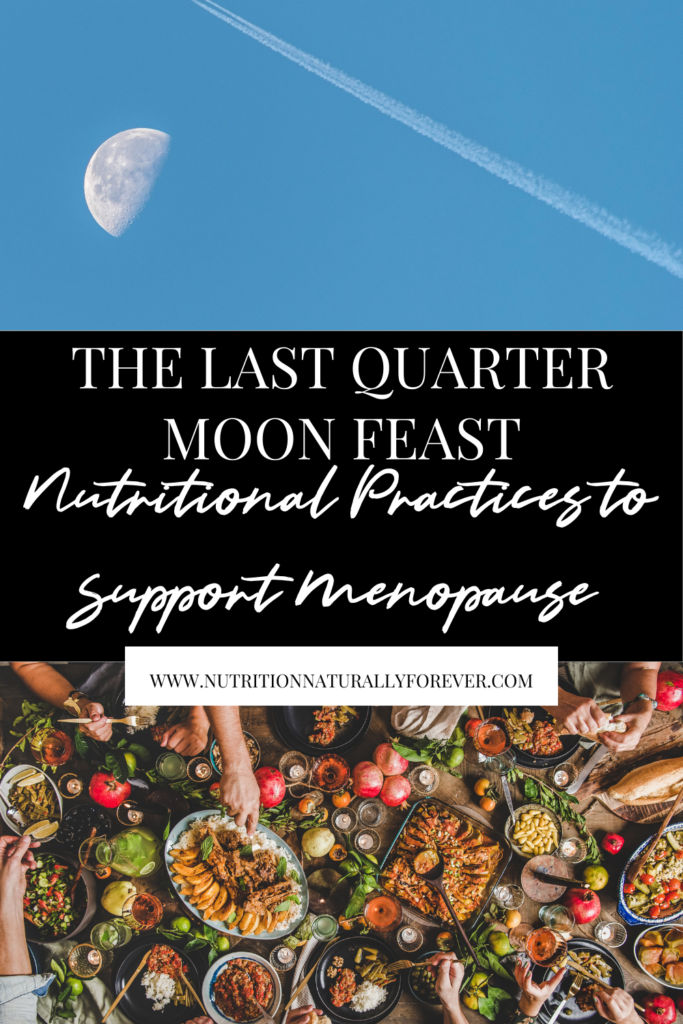
The Last Quarter Moon Feast: Nutritional Practices to Support Menopause.
Did you enjoy the Full Moon phase?
What did you notice about your own body?
- Increased energy?
- Decreased energy?
- If you still have a cycle is it aligned with the moon or opposite?
Following the ovulation phase is the longest phase of the cycle, the luteal phase.
This part of the cycle can last up to two weeks and aligns with the waning of the moon from the full moon back through to the new moon.
It begins on the day after ovulation and lasts until the first day of your period.
Or if you are anything like me you could be on day 112 and counting!!! Which is why I choose to sync with the moon.
To catch up on previous cycle posts follow these links;
Read on for nutrition and rituals for the last quarter moon feast.
The Last Quarter Phase
Here is a recap of the phases of the moon and how they closely relate to the seasons and the female cycle;
- New Moon – First day of bleeding – Winter
- First Quarter Moon – Follicular phase – Spring
- Full Moon – Ovulation – Summer
- Last Quarter Moon – Luteal phase – Autumn
So this week we are nourishing our bodies according to the luteal phase.
The collective energy begins to calm down as the moon appears to shrink in the sky.
This is the Autumn phase of your cycle, it’s all about finishing up, completing actions that you planned to achieve your goals set at the new moon and organising and tidying up loose ends ready for turning inwards.
If you still have a cycle, biologically your body is preparing for pregnancy. Progesterone begins to rise increasing feel-good emotions and encourages cleaning and organising or ‘nesting’.
Now is the time to get on with those cleaning or sorting jobs you have been putting off!
If pregnancy doesn’t occur then progesterone levels drop and the body prepares to release the uterine lining.
At around day 20 estrogen fluctuates and along with the drop in progesterone, you may feel emotional and susceptible to PMS symptoms such as bloating, cramps and skin breakouts.
During this phase, the Wild Woman is born and if you are on your menopause journey she is here to stay!
The Last Quarter Moon Rituals
Towards the end of this phase lean into self-care, whatever that looks like for you, try not to confuse self-care with self-comfort.
With the increased progesterone you may notice an increased desire for sleep or that you sleep better.
Increase your practices of honouring your mind, body and spirit to reduce symptoms of PMS, and tune into what your body needs, here are some suggestions;
- No, is a complete sentence.
- Get to bed early.
- Slow down.
- Nest, make your space safe and comforting.
- Practice gratitude, we can’t always be happy but we can be grateful.
- Journal. Getting your thoughts on paper can be insightful.
The Last Quarter Moon Feast
The main focus of the luteal phase is to support progesterone production. Too little progesterone can lead to a shorter cycle.
During this phase, you may notice an increase in cravings for starchy carbohydrates such as pastries, cakes, and biscuits. These foods support the feel-good neurotransmitters along with B vitamins from grains which will help increase progesterone levels.
Focus on nourishing your body with complex starchy carbs such as whole grains, brown rice, oats, buckwheat and root veggies such as sweet potato and parsnips along with apples, berries and leafy greens, think autumnal comforting foods.
During menopause, while B vitamins are important, vitamin B6 is essential for progesterone production and also helps to reduce inflammation and remove excess estrogen from the body to support a reduction in PMS symptoms.
Anovulatory cycles (cycles without ovulation) become more frequent as you progress through the menopause journey. If you aren’t ovulating your body is producing less and less progesterone increasing the imbalance between progesterone and estrogen.
However, remember this is the natural transition from peri-menopause to post-menopause.
Humans are one of the very few mammals that experience menopause, we have value to nature AFTER our ability to reproduce is complete.
The goal of the transition through menopause is to make it as easy as possible, not to stop it from happening.
Foods rich in vitamin B6 include avocados, bananas, beef, chicken, garlic, salmon, spinach, sweet potatoes and tuna.
Magnesium and calcium support the body through PMS by helping to reduce fluid retention, constipation and headaches.
Increase these minerals naturally by including foods such as apricots, beans, brown rice, cacao, cheddar cheese, leafy greens, molasses, nuts, seaweeds, sesame seeds and tofu.
By the end of this phase, you will start your bleed or welcome the new moon and the cycle starts again.
Once you have experienced 12 months without a natural menstrual cycle (without contraception or HRT) you are now post-menopause.
You are still a cyclical being, your hormones are produced mainly from the adrenal glands which is why stress reduction is even more important through menopause and beyond.
Nourishing your body in this cyclical way post-menopause will ensure your body has a wide range of nutrients available to promote hormone harmony and stress reduction.
I hope that you have found linking and following the moon phases with your cycle has helped you connect more deeply with your own body and the natural world around you.
If you would like support with this, read on.
Hormone Harmony Naturally
Download my free eBook and discover the Top 5 Nutrients Your Body Needs through menopause and beyond.
Alternatively, discover how to naturally create hormone harmony by nourishing your body in alignment with your menstrual cycle or the moon’s phases.
Explore a holistic approach that aligns your nutrition with your unique menopause journey.
Moonlight Menopause: Align Your Nutrition with Natural Rhythms

Discover the Wild Well-Being Membership – reconnect with your body and thrive through menopause with holistic health, moon cycle alignment, and personalised astrology awaiting you inside.
